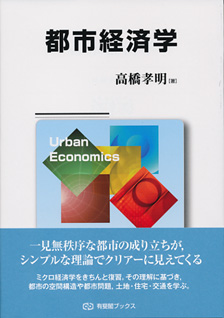
Title
Yuhikaku Books Toshi Keizaigaku (Urban Economics)
Size
344 pages, A5 format, softcover
Language
Japanese
Released
October, 2012
ISBN
978-4-641-18406-0
Published by
Yuhikaku Publishing
Book Info
See Book Availability at Library
This book explains the basics of urban economics for introductory-level students.
Urban economics is a field of economics that studies how economic activities are carried out in cities, the problems that arise from them, and the policies that are effective in resolving those problems. The population living in cities is steadily increasing not only in Japan but throughout the world, which makes cities increasingly important as places of production and consumption. At the same time, a variety of urban problems has newly appeared or intensified whose resolution is becoming increasingly urgent.
Let me introduce the content of the book in more detail.
Part I discusses how to define a city. The most important factor in the definition is arguably a high population concentration in a relatively small area. After describing several statistical areas consistent with that definition, the book discusses the mechanism whereby economic activities are agglomerated in a small area. Here, the notion of “agglomeration economies” plays an important role. Recent years have seen the rise of debates on the excessive agglomeration of economic activities in the Tokyo metropolitan area. To grasp this problem, we need to correctly understand such agglomeration economies.
Part II explains the spatial structure within a city as a consequence of individual residents' decision-making processes as they choose whether to live near a city center in a small house that saves commuting costs, or to live farther from the center in a big house, reluctantly paying high commuting costs; they select the solution to this trade-off most desirable to themselves. Such individual choices result in macro-scale phenomena such as the well-documented fact that the land rent decreases as we gradually move from a city center toward the suburbs, but the extent of that decrease shrinks with distance. The analysis presented in this part plays an important role in the discussion of many imminent urban problems and policies, including compact city policies and the decline of a central business district in most smaller cities in Japan.
Part III studies the three markets that are particularly relevant in urban economies, namely, the markets for land, housing, and urban transportation. We see how the prices and quantities sold are determined in each of the three markets, and discuss the benefits and costs of various policies that affect the factors acting in these markets. We can thereby obtain a clue to understanding diverse urban problems in Japan, such as the too-low intensity of land use in the centers of big cities, the steadily increase in vacant houses, and the never-ending congestion in urban railways and local road transportation.
Those who read this book live in a city or have at least visited one, and thus they have conducted economic activities in a city. In this sense, it is quite natural for them to study urban economics.
(Written by TAKAHASHI Takaaki, Professor, Center for Spatial Information Science / 2021)



 Find a book
Find a book

